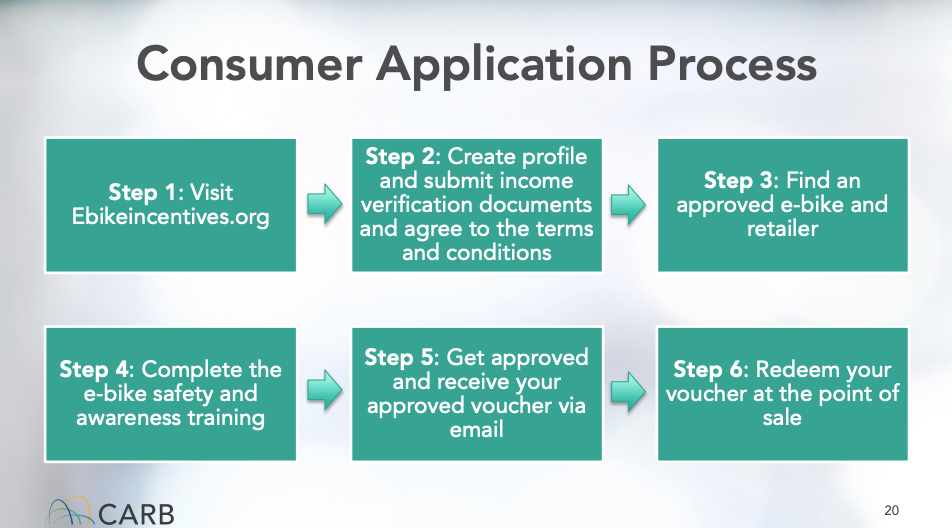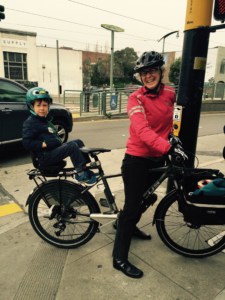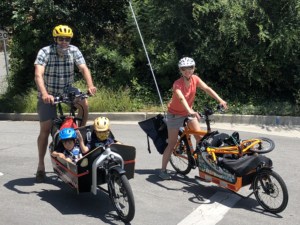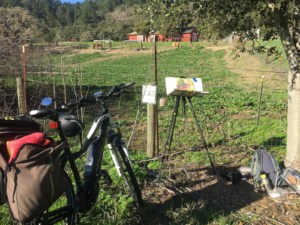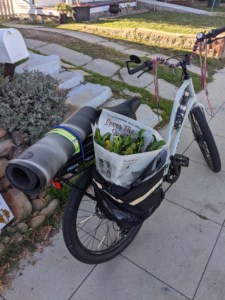How to Fight E-Bike Backlash
In a state where 4,000 people die annually and many more are injured due to traffic violence, some California cities are freaking out because teenagers on e-bikes…did a wheelie? The ultra-conservative enclave of Huntington Beach enacted a draconian law last year that allows police to impound bicycles of youth found to have violated its (probably unconstitutional) provisions. Now, Santa Barbara is considering an ordinance based on the Huntington Beach law.
The popularity of e-bikes — and the confusion of small motorbikes with e-bikes — has led some local governments to declare states of emergency and restrict and penalize people on e-bikes. There have been very few fatalities, almost exclusively caused by car drivers hitting people on e-bikes, so the car is the problem in those cases.
There have been increased interactions between people riding e-bikes, including out-of-class bikes that might more properly be classified as mopeds, and pedestrians on shared paths. This can be scary, especially to older pedestrians, and it’s understandable that communities want to create an atmosphere of safety on mixed-use paths. Criminalizing e-bike riders doesn’t solve this problem and, in fact, creates more safety hazards than it fixes.
CalBike has created a toolkit advocates can use if local elected officials propose regulations that will discourage or prevent people from riding e-bikes (and all bikes). Scroll to the bottom of this post to download it.
6 reasons to oppose criminalizing e-bike riders, even if you don’t ride an e-bike
To paraphrase a famous saying, “First they came for the e-bikes….” Over-policing of e-bikes hurts everyone in the bicycling community and impedes public safety. Here’s why everyone who supports active transportation should speak out against unfair e-bike regulations.
- All bike riders will be targeted. Some e-bikes are obviously electric, but many look very similar to acoustic bikes with a battery tucked discreetly against the frame or even hidden inside the frame. When police target e-bike riders, they are bound to harass some people riding acoustic bikes as well.
- Bike police stops are racist. An in-depth investigation by the LA Times showed police disproportionately pulled over Black and Latino bike riders, and data from other municipalities has revealed the same pattern. Who is most likely to get pulled over for a suspected e-bike infraction? Who is most likely to have their bike impounded? Riders who are “other,” “outsiders,” or “a threat” — in other words, BIPOC bike riders.
- Traffic stops can have fatal consequences. Police encounters, especially for men of color, can turn deadly. E-bikes almost never kill anyone, but police officers do. Even nonfatal stops can leave bike riders physically and emotionally traumatized. No one should have to go through that to ride a bike. California has moved to decriminalize things like “jaywalking” to reduce the frequency of police encounters; criminalizing e-bike riders is a move in the wrong direction.
- Demonizing bike riders makes everyone less safe. Studies have shown that when drivers view people on bikes as less human, they are more likely to drive dangerously around them. Cities that treat e-bike riders as criminals invite car drivers to drive too close, cut off bike riders, or menace them with their cars, increasing the risk of injury or death.
- Criminalizing any kind of bike riding makes people less likely to ride. Getting around on any kind of bike is economical, healthy, and fun. But getting on a bike is less appealing if you think you might be subject to a $500 fine or have your bike impounded. If you are forced to ride in fast-moving traffic or restricted from bike paths, going out for a ride might not seem like much fun.
- It’s the wrong solution to the wrong problem. Our planet is heating and we need to drive less and bike, walk, and take transit more. If there are too many e-bikes clogging up a city’s streets, treat bike congestion the way you would treat car congestion and build more bikeways, bike paths, and shared-use paths. If there are conflicts between pedestrians and people on e-bikes, build even more bikeways with fast lanes or bicycle highways that provide limited-access through routes. Restrict where people can drive cars and make space for active transportation. These measures aren’t as easy as writing a law blaming everything on people riding e-bikes, but they will make streets safer for everyone.
What is and isn’t an e-bike
One of the challenges with e-bikes is that California regulations haven’t caught up with the surge in the popularity of e-bikes. That has allowed new companies to bring out models marketed as e-bikes that have settings like “off-road” that allow the bikes to travel faster than the maximum 28 mph of a Class 3 e-bike. Many of these vehicles don’t fit California’s definition of an e-bike.
CalBike supported bills this year to clarify e-bike classifications and require safety certifications for e-bike batteries to prevent fires. We are working with legislators to develop additional sensible regulations to keep everyone safe on e-bikes in California.
We believe regulating the e-bike market and e-bike use should be done at the state level. For example, if age limits on e-bike riding change from city to city, a rider could break the law, without realizing it, just by crossing a municipal boundary.
And, as noted above, the local ordinances that have been considered or put into effect don’t address these safety concerns but rather penalize all e-bike riders — and everyone who rides a bike.
How to use CalBike’s toolkit
We wish we could weigh in on every new e-bike ordinance, but in a state the size of California, it’s not possible. We’re counting on local bicycle coalitions, advocates, and concerned citizens to stand up against anti-bike regulations.
In the toolkit provided in the pdf below, we include common provisions we’ve seen in e-bike regulations and responses to them. We also include talking points you can use when testifying at a city council meeting about a proposed law and a template letter to send to your local elected representatives.
Thank you for being a bike champion and standing up for the rights of all bike riders.

